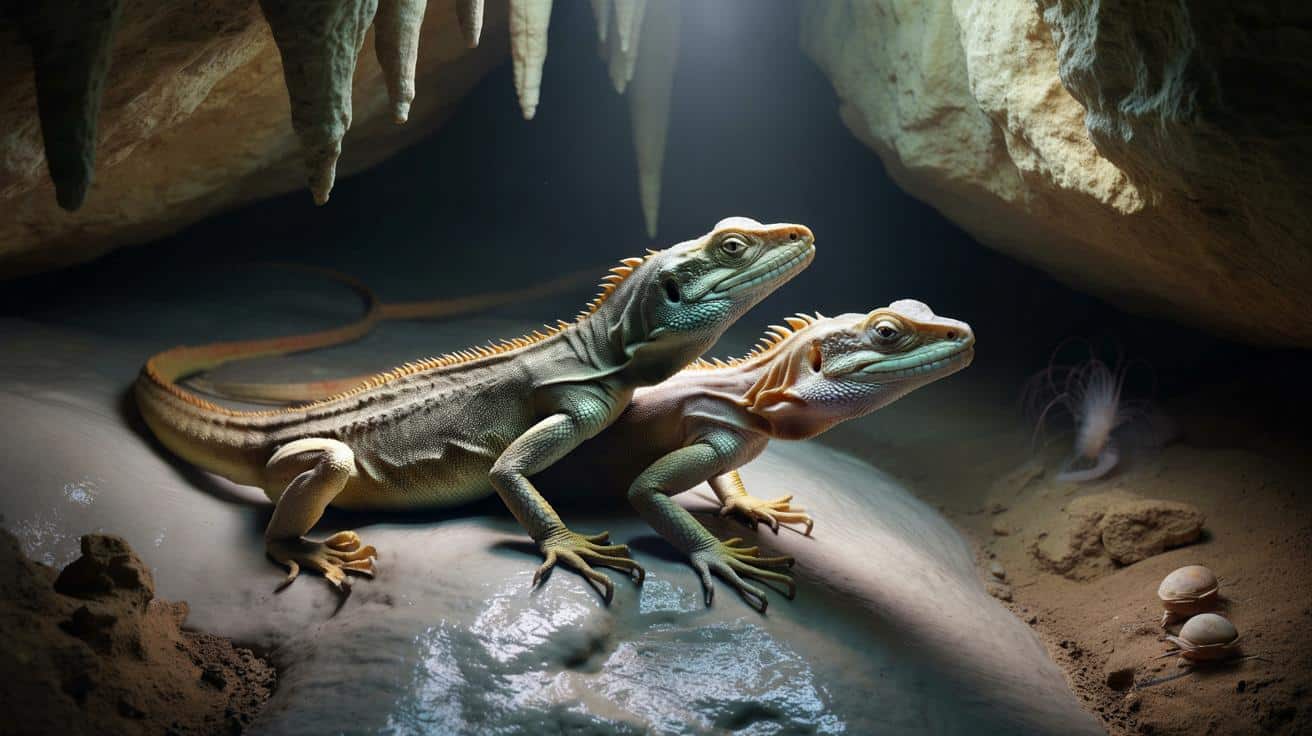Deep in a Thai cave, two “dragon”-like lizards were caught in a glittering embrace. That fleeting moment unlocked a brand-new species.
Headlamps cut through the damp, bouncing off limestone ribs, and the cave breathed back at us. The air tasted of rust and rain, the kind that sticks to your tongue and your memory.
Someone whispered and the beam steadied. There, clinging to a slick wall, two spiny, long-tailed reptiles were locked together, tails twined, claws hooked into pale rock. Their backs carried a low jag of scales that looked theatrical in the light, a medieval silhouette come alive. A quiet shutter clicked.
We’ve all had that moment when a story you told yourself suddenly feels small. The headlamps slid lower, the cave seemed to lean in, and the “dragons” did not flinch. A scientist traced a finger through the air, sketching the outline of a creature no field guide had yet claimed. A legend blinked back.
A moonlit surprise in a limestone maze
They weren’t breathing fire; they were breathing the cave. The mating pair held fast to a flowstone curtain, skin marbled like old bronze, eyes lacquered and calm. Each head wore a subtle brow ridge, and a neat line of keeled scales ran the spine like a stitched seam. When the male shifted, a dewlap flashed a muted citron, then folded away as quickly as a secret.
Local rangers had talked about “little dragons” on wet nights, shadows skittering near the cave mouth after monsoon showers. On this trip, guides stopped, tilted their torches, and there it was: a small world happening at human height. The cave’s drip tempo was slow; the lizards’ patience was slower. One researcher watched the pair for 23 minutes, counting the rhythm of their stillness, recording the microclimate on a wrist meter as the humidity climbed.
Why does a mating sighting matter? Because context is a fingerprint. Behaviour, microhabitat, timing, and body detail stack into a pattern that distinguishes species even when cousins look near identical. In karst landscapes, where limestone carves caves into islands of habitat, evolution writes in tight handwriting. The team compared scalation and limb ratios, then paired that with DNA barcodes from shed skin—evidence that this wasn’t just a dramatic pose, but a lineage with its own map.
From flashlight photos to formal science
Fieldwork started with a simple ritual: slow down, breathe with the cave, and take in the scene before touching a notebook. Photos came first, wide to tight, with a pen clipped into frame for scale. Next, non-invasive swabs for DNA and quick morphometrics—snout-to-vent length, tail-to-body ratio, subdigital lamellae counts—before the pair eased apart and vanished into the rock’s wrinkles. Back at base, micro-CT scans mapped the skulls without a scalpel.
If you’re picturing a cinematic dash for a specimen, park it. Real discovery reads more like patient admin married to reverence. Keep your light low and warm, move sideways rather than straight on, and give the wildlife your silence. Let’s be honest: nobody logs cave temperatures at 3am every day. Still, note the basics—time, weather, the exact perch, even the drip cadence. These small things turn a story into data.
Ethics matter in tight ecosystems. Go in with a local guide, keep hands off walls slick with life, and kill the flash where bats roost. Discovery means nothing if the habitat pays the price. One ranger described it best, nodding toward the dark:
“Leave less than a footprint, take more than a memory.”
- What set these “dragons” apart: a low crest, marbled dorsum, and a subdued citron dewlap.
- Where they lived: a humid limestone corridor, midway between the vents and the twilight zone.
- How the team proved it: scalation counts, limb ratios, and DNA barcoding of shed skin.
- What happens next: formal naming, range surveys, and talks with local communities.
Why these ‘dragons’ matter now
Thailand’s limestone belt is a rugged archive of things that survive by specialising. A new cave species is not a trivia item; it’s a memo from an ancient system with modern threats. Quarrying nibbles at hillsides, footfall echoes deeper every tourist season, and heatwaves tweak the thermostat of places built for cool. The lizards’ debut arrives with a question mark shaped like a tail.
Stories like this travel fast because the word “dragon” does half the work. Yet the real hooks are humbler: two animals holding their nerve while humans fumble with notebooks. Think of the lineage they represent, the neighbours we didn’t see: whip scorpions tucked into seams, tiny snails etched like punctuation, blind fish grazing on bacteria film. **A single cave can be a city, and cities can fall quietly.** The thrill and the duty are the same sentence.
So what now? Taxonomists will polish a Latin name, museums will accession scans, and maps will sprout pins as new surveys fan out along the karst. Locals will trade stories with researchers over iced tea, because that’s how good fieldwork works. The rest of us can hold a small vow: that wonder should not be a bulldozer’s preface. **We don’t need myths to feel awe. We need time, care, and a working torch.**
Back in that cave, the water kept ticking. The lizards separated, the rock took them back, and the night hummed on like a generator in another room. Somewhere up on the ridge, a gecko clicked and the forest answered with soft, leafy applause. The researchers hiked out with mud around their ankles and a story that would keep them awake on the bus. These “dragons” are new to science, old to the cave, and just visible long enough to change the way you look at a wall.
| Point clé | Détail | Intérêt pour le lecteur |
|---|---|---|
| Discovery in a cave | Mating pair of dragon-like lizards observed on flowstone in southern Thailand | Sets the scene and explains why this wasn’t a random sighting |
| Proved as new species | Scalation counts, limb ratios, and DNA barcodes from shed skin and swabs | Shows the science behind the headline—more than a pretty photo |
| What it means | Fragile karst ecosystems, local guides, and low-impact visits | Actionable takeaways for travellers and wildlife fans |
FAQ :
- Are these “dragons” real dragons?They’re lizards with spiny crests and long tails, not fire-breathers. The nickname comes from their medieval silhouette in torchlight.
- Where exactly were they found?In a limestone cave within Thailand’s karst belt, in the humid corridor between daylight and full dark. The precise site is kept vague to protect the habitat.
- Are they dangerous?No. They’re shy, small, and more likely to freeze than fight. A nip is possible if handled, which is a good reason not to handle them.
- Can visitors see them?Possibly, with a licensed local guide and a quiet approach near cave mouths after rain. Keep lights low, avoid bat roosts, and give wildlife space.
- Do they have an official name yet?The species has been described by researchers and will carry a formal Latin name. Until that filters through, the field nickname “limestone dragon” has stuck.









Mind blown—“dragons” in Thailand and they’re new to science? Wild.
Cool read, but how can you be sure it’s not a cryptic variant of a known species? Shed-skin DNA can get contaminated, and scalation counts can overlap. Did the barcodes meet standard divergence thresholds (e.g., >2% COI)? Genuinly curious.